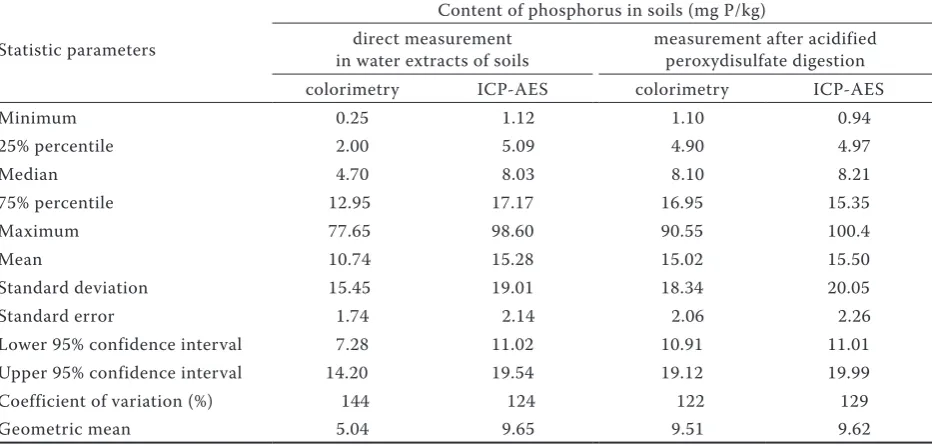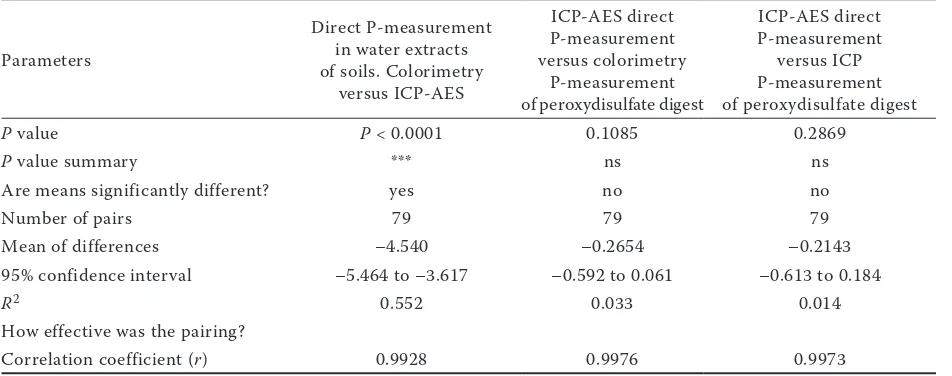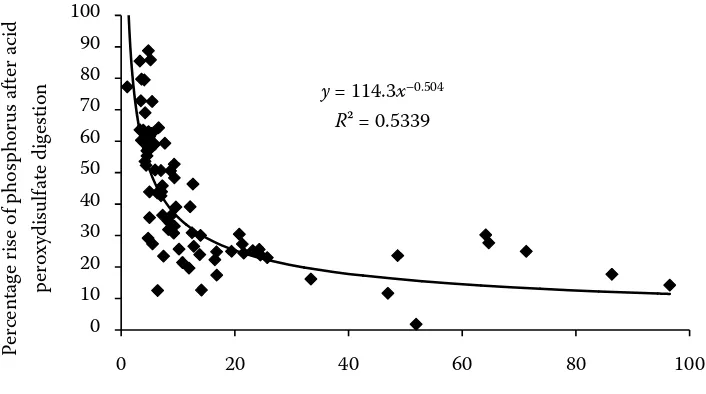The emphasis on environmental aspects in any human activity has also an impact on the routine testing of the nutrient status of soils. Today’s chal-lenge is the innovation of the primary agronomic role of routine soil testing for an improvement in the use of fertilizers to reach high yields of crops and for minimizing the losses of nutrients from soils into the environment, mainly nitrogen and phosphorus environmental impacts on water quality.
Water-extractable phosphorus from soils pro-vides important information on the availability of phosphorus for plants, and its importance is currently increasing also in view of environmental aspects connected with potential losses of phos-phorus into surface waters (Matula 2009). The phosphorus concentration detected by means of molybdenum-blue colorimetry is called, from an environmental aspect, ‘dissolved reactive phos-phorus (DRP)’. The term ‘dissolved unreactive phosphorus (DUP)’ is used for phosphorus that does not react with the agent Mo-blue. The sum of DRP and DUP expresses ‘dissolved total phosphorus (DTP)’ (Robards et al. 1994, Worsfold et al. 2005,
Styles and Coxon 2006, Soldat et al. 2009, Regan et al. 2010). Dissolved unreactive phosphorus is mainly attributed to ‘organic phosphorus’. Water extract of soils is generally characterized by low ionic strength, which allows the existence of a fine colloid fraction of inorganic and organic nature, of the particles phosphorus may be fixed to. The term ‘particulate phosphorus’ is used for phos-phorus fixed to soil particles. In environmental chemistry phosphorus bound to particles that pass through the filter with pores 0.45 μm in size is considered as particulate phosphorus (Worsfold et al. 2005, Styles and Coxon 2006, Blackwell et al. 2009, Ebeling and Davis 2009). However, for the filtration of soil extracts during routine testing of soils filter papers with larger pore sizes are used for practical reasons, e.g. in the Whatman grade no. 40 filter paper the pore size 8 μm is indicated. Direct filtration of water extracts of soils is dif-ficult and time-consuming due to a high propor-tion of uncoagulated particles. This is the reason why centrifugation, which solves this problem, precedes filtration.
Determination of dissolved reactive and dissolved total
phosphorus in water extract of soils
J. Matula
Crop Research Institute, Prague, Czech Republic
ABSTRACT
The simplified acid peroxydisulphate digestion of soil water extract was evaluated for determination of total dis-solved phosphorus by molybdenum-blue colorimetry in comparison with direct P-detection in water extract by the ICP-AES technique. The research was conducted on 79 agricultural soils with different agrochemical characteris-tics. The results of the colorimetric P detection in water extract without digestion and ICP phosphorus detection were different. The median of values determined by ICP-AES was 1.7 times higher than that of colorimetry, but the correlations between the two measurements were quite close (r = 0.993). Differences between the colorimetric phosphorus and ICP-AES phosphorus were irregular, increasing as the phosphorus level in soils decreased. The simplified procedure of acid peroxydisulphate digestion is useful for routine determination of total water-extracted phosphorus in soils when the soil testing laboratory is not equipped with the ICP-AES technique. The two-tailed paired t-test did not prove any difference in the values between the direct ICP-AES P-detection in water extract of soils and colorimetric P-detection in the acid peroxydisulphate digest.
Keywords: soils; water-extractable phosphorus; colorimetry; ICP-detection; acid peroxydisulphate digestion
Colorimetry by means of the reduced phospho-molybdenum blue complex has always been the most widespread analytical method of phosphorus determination; mainly the detection of inorganic phosphorus, orthophosphate ions, is assumed in this method. A new technique used more and more frequently is determination of phosphorus with ICP instruments when total phosphorus, including organic phosphorus, should be detected.
In colorimetric determination of phosphorus aimed at detection of total phosphorus preceding mineralization of the water extract is necessary that will allow the determination of total phosphorus, i.e. including phosphorus primarily unreactive with molybdenum blue colorimetry. The differ-ence between the values of direct colorimetric determination of phosphorus in the extract and those after its mineralization is explained by un-reactive phosphorus, which mainly represents or-ganic phosphorus (Worsfold et al. 2005, Styles and Coxon 2006, Blackwell et al. 2009). The detection of organic phosphorus portion is also feasible by direct colorimetry of the unmineralized extract of soils because hydrolytic splitting off of inorganic phosphorus (orthophosphate) may take place in the staining process in the low pH (2) medium (Baldwin 1998).
Digestion techniques for environmental samples are necessary for determination of total phospho-rus (TP) and total dissolved phosphophospho-rus (TDP). This is because many of the phosphorus species present contain P-O-P, C-O-P and C-P bonds that need to be broken down to release phosphorus as phosphate, which can then be determined using colorimetry technique by phosphomolybdenum blue complex. A number of digestion methods, mostly rather time-consuming and requiring so-phisticated laboratory equipment, were described (Worsfold et al. 2005). Rowland and Haygarth (1997) recommend acidified persulfate digestion as the best method for the analysis of soil solution or leachates because it produced reliable and ac-curate data. Currently, acid mineralization with potassium peroxydisulphate is the most widespread method of water fraction mineralization.
Phosphorus determination with ICP instruments should correspond to the determination of total phosphorus, i.e. including organic phosphorus. The advantage of ICP is an expeditious determina-tion, without time-consuming mineralization of the extract. On the other hand, to buy an ICP-AES instrument is a costly investment and it also lacks the sensitivity to determine P concentrations below 100 µg/L (Rowland and Haygarth 1997).
The objective of this study was to develop a less labour-consuming and technically less complicated digestion technique of the water extract of soils that would be easily used in routine agrochemical testing of soils. Another aim was to test the correspondence between colorimetric determination of phosphorus after simplified digestion with acid peroxydisulphate and direct determination of phosphorus in water extract with an ICP-AES instrument.
MATERIAL AND METHODS
Research was conducted on 79 soil samples taken from the surface profile of agricultural lands in different localities of the Czech Republic. After air-drying the soil samples were homogenized by screening through a 2-mm sieve.
The following important basic agrochemical soil characteristics were determined: pH (0.2 mol KCl/ dm3 solution at a 1:1 ratio (w/v), CEC value
(accord-ing to Matula (1996) and content of oxidizable soil organic matter (according to Sims and Haby 1971).
Extraction procedure: shake 20 g of soil with 100 ml distilled water for 1 h. Prior to filtration the suspension centrifuge at a relative centrifugal force of 12 680 g for 10 min at 20°C. The filter paper Filtrak grade 389 was used for the filtration (or Whatman No. 40).
Procedure of acid peroxydisulphate digestion: transfer an aliquot of 50 ml filtrate into the 100 ml digestion volumetric flask. Add 0.6 g K2S2O8 with a scoop and 3 ml 2 mol H2SO4/dm3 to the digestion
flask and mix. Put flaks on the heat block 125°C for 90 min. Remove digestion flasks from the heat block and let it cool down to laboratory temperature. Make up to 100 ml with distilled water and mix. Filter through paper Filtrak, grade 389 or Whatman No. 40. Digestion procedure was adopted from the Skalar CD handbook (2007).
Results were evaluated by the statistical pro-grammes GraphPad PRISM, Ca., USA, version 3 and Microsoft Excel 2007.
RESULTS AND DISCUSSION
Table 1 shows information of the content of soil organic matter, cation exchange capacity and pH values. The range of oxidizable carbon content was between 0.85 and 5.13% C, with the median 1.96% C. Cation exchange capacity of soils ranged from 59 to 305 mmol+/kg with the median 137. The values of pH (0.2mol/dm3) KCl were in the
range 3.55 to 7.21 with the median 5.67. The above values of the basic characteristics of the used set of soils document great heterogeneity of used soils.
[image:3.595.64.532.79.218.2]Obviously, marked differences were recorded between colorimetric determination and ICP in the results of the water extract analysis at a 1:5 ratio (w/v) without peroxydisulphate digestion (Table 2). The median of the ICP measured val-ues of phosphorus content in soils was 1.7 times higher than in colorimetric determination. The two-tailed paired t-test (Table 3) demonstrated a statistically significant difference among data sets, but with a high correlation among the sets (r = 0.9928). The differences between the higher values of ICP and colorimetric values were not uniform in the determined range of P content in soils. Similarly as in Matula (2010), the difference between phosphorus detection by ICP and that by colorimetry relatively increased as the phosphorus reserve in soils decreased. The difference between Table 1. Column statistics of basic soil charakteristics (79 analyzed soils)
Statistic parameters Oxidized organic matter (% C) CEC mmol+/kg pH 0.2 mol KCl/dm3
Minimum 0.850 59 3.55
25% percentile 1.60 128 5.24
Median 1.96 137 5.67
75% percentile 2.52 153 6.28
Maximum 5.13 305 7.21
Mean 2.17 144 5.74
Coefficient of variation (%) 38.22 27.50 12.96
Geometric mean 2.03 139 5.69
Table 2. Column statistics of phosphorus in water extract of 79 soils determined by phosphoantimonyl blue colorimetry and by inductevely coupled argon plasma atomic emission spectrophotometry (ICP-AES) measured directely in water exctract and after acid peroxydisulfate digestion
Statistic parameters
Content of phosphorus in soils (mg P/kg) direct measurement
in water extracts of soils measurement after acidified peroxydisulfate digestion
colorimetry ICP-AES colorimetry ICP-AES
Minimum 0.25 1.12 1.10 0.94
25% percentile 2.00 5.09 4.90 4.97
Median 4.70 8.03 8.10 8.21
75% percentile 12.95 17.17 16.95 15.35
Maximum 77.65 98.60 90.55 100.4
Mean 10.74 15.28 15.02 15.50
Standard deviation 15.45 19.01 18.34 20.05
Standard error 1.74 2.14 2.06 2.26
Lower 95% confidence interval 7.28 11.02 10.91 11.01
Upper 95% confidence interval 14.20 19.54 19.12 19.99
Coefficient of variation (%) 144 124 122 129
[image:3.595.65.532.539.762.2]ICP determination and colorimetry can be consid-ered as organic phosphorus including particulate phosphorus (Worsfold et al. 2005, Styles and Coxon 2006, Blackwell et al. 2009). The detection limit of 100 μg P/L is reported for the determination of phosphorus concentration in a solution by the ICP technique (Rowland and Haygarth 1997). In our set of soils in a direct measurement of the concentration in soil extract by the ICP technique the lowest detected concentration was 220 μg P/L. Hence it is to assume that the lower sensitivity of ICP determination should not influence the com-parison of the results of phosphorus determination with those of colorimetry.
The main objective of our study was to test the functionality of a simplified method of water ex-tract digestion for determination the total content of dissolved phosphorus in soil water extract, so called total reactive phosphorus (TRP) (Robards et al. 1994, Worsfold et al. 2005). The simplified method of water extract digestion was based on the Skalar method (2007). The determination of phosphorus by ICP technique should directly detect the concentration of total phosphorus (Rowland and Haygarth 1997) while colorimetry should determine inorganic phosphorus (Worsfold et al. 2005) even though according to Baldwin (1998) orthophosphate ions could be released from eas-ily hydrolysable ester bonds of phosphorus under the conditions used in the standard ascorbic-acid/ molybdenum-blue method. The paired t-test be-tween direct measurement by ICP and colorimetric determination of phosphorus after digestion by a simplified method did not prove any differences between these determinations but their corre-spondence was shown (Table 3). No differences
were demonstrated between the measurements of phosphorus concentration by ICP technique directly in water extract and after its digestion.
In phosphorus detection by ICP after acid per-oxydisulphate digestion, we achieved the ICP detection limit in solution 100 μg P/L in a soil with low phosphorus content. Phosphorus concentra-tion after digesconcentra-tion in the soil with low phospho-rus content was 94 μg P/L as the original water extract was diluted after digestion. An amount of 50 ml of the soil extract was pipetted into 100-ml flasks for acid peroxydisulphate digestion. When after digestion distilled water was added (to the gauge mark) to the digest to obtain the volume of 100 ml, the dilution of the original extract was twofold. Then the reliability of the determined concentration of phosphorus in the range of 100 μg P/L is low (Rowlanda and Haygarth 1997). However, soils with low phosphorus content were exceptions in our set.
Our results obtained in a heterogeneous set of 79 soils document that the simplified method of acid peroxydisulphate digestion and subsequent colorimetric detection of phosphorus can be used for routine determination of total phosphorus in the water extract of soils if the instruments for ICP technique are not available in a laboratory. The method of simplified acid peroxydisulphate digestion is substantially less labour- and time-consuming compared to more complicated di-gestions by conventional methods (dry ashing, perchloric acid, sulphuric acid, nitric acid diges-tion) or autoclaving with sealed vessels (Worsfold et al. 2005).
[image:4.595.63.539.79.267.2]Figures 1 and 2 illustrate the determined irregular-ity of a relative phosphorus increment in the digest Table 3. Results of two-tailed paired t-tests
Parameters
Direct P-measurement in water extracts of soils. Colorimetry
versus ICP-AES
ICP-AES direct P-measurement versus colorimetry
P-measurement of peroxydisulfate digest
ICP-AES direct P-measurement
versus ICP P-measurement of peroxydisulfate digest
P value P < 0.0001 0.1085 0.2869
P value summary *** ns ns
Are means significantly different? yes no no
Number of pairs 79 79 79
Mean of differences –4.540 –0.2654 –0.2143
95% confidence interval –5.464 to –3.617 –0.592 to 0.061 –0.613 to 0.184
R2 0.552 0.033 0.014
How effective was the pairing?
of water extract in relation to the phosphorus reserve in soil detected colorimetrically and by ICP. Similarly as in Matula (2010) a steep increase in the concentration of probably organic and par-ticulate phosphorus was observed at a low level of water extractable phosphorus in soil. At a higher level of phosphorus in soil a difference between the direct determination of phosphorus and that after its mineralization was on average 20%. It is to assume that the difference corresponds mainly to particulate phosphorus due to the low ionic strength of water extract that limits the aggregation
of soil particles (Ebeling and Davis 2009). At a higher phosphorus levels in soil the exception was observed in the soil with an extremely high level of exchange-able potassium (700 mg K/kg) where no difference practically existed between the direct measurement of water extract and that after its digestion. It may be explained by the substantially higher ionic strength of water extract that caused the more pronounced coagulation of particulate phosphorus on fine soil particles that were captured by centrifugation and extract filtration compared to the other soils with a lower ionic strength of water extract.
y= 70.234x– 0.404
R² = 0.6748
0 10 20 30 40 50 60 70 80 90 100
0 10 20 30 40 50 60 70 80
Pe
rc
en
tage r
ise
of phosphor
us
af
te
r ac
id
pe
ro
xydi
sulf
at
e digestion
Water-extractable phophorus determined by colorimetry (mg P/kg)
y= 114.3x–0.504
R² = 0.5339
0 10 20 30 40 50 60 70 80 90 100
0 20 40 60 80 100
Pe
rc
en
tage r
ise
of phosphor
us
af
te
r ac
id
pe
ro
xydi
sulf
at
e digestion
[image:5.595.120.441.63.255.2]Water-extractable phophorus detected by ICP-AES technigue (mg P/kg)
Figure 1. Percentage rise of phosphorus in water extracts of soils after acid peroxydisulfate digestion of water extracts related to the direct determination of phosphorus in water extracts of soils by colorimetry
[image:5.595.108.461.500.697.2]Corresponding author:
Doc. Ing. Jiří Matula, CSc., Výzkumný ústav rostlinné výroby, v.v.i., Drnovská 507, 161 06 Praha 6-Ruzyně, Česká republika
e-mails: matula@vurv.cz, matula.jiri@email.cz REFERENCES
Baldwin D.S. (1998): Reactive ‘organic’ phosphorus revisited.
Water Research, 32: 2265–2270.
Blackwell M.S.A., Brookes P.C., Fuente-Martinez N. de la, Mur-ray P.J., Snars K.E., Williams J.K., Haygarth P.M. (2009): Ef-fects of soil drying and rate of re-wetting on concentrations and forms of phosphorus in leachate. Biology and Fertility of
Soils, 45: 635–643.
Ebeling D.D., Davis J.G. (2009): Impact of experimental factors in soil phosphorus tests: shaking vessel, filtration, and centrifu-gation. Communications in Soil Science and Plant Analysis,
40: 1610–1623.
Matula J. (1996): Determination of potassium, magnesium, phos-phorus, manganese and cation exchange capacity for fertilizer recommendations used by Czech Union of Rapeseed
Grow-ers. Communications in Soil Science and Plant Analysis, 27:
1679–1691.
Matula J. (2009): A relationship between multi-nutrient soil tests (Mehlich 3, ammonium acetate, and water extraction) and bio-availability of nutrients from soils for barley. Plant, Soil and
Environment, 55: 173–180.
Matula J. (2010): Differences in available phosphorus evaluated by soil tests in relation to detection by colorimetric and ICP-AES
techniques. Plant, Soil and Environment, 56: 297–304.
Regan J.T., Rodgers M., Healy M.G., Kirwan L., Fenton O. (2010): Determining phosphorus and sediment release rates from five
Irish tillage soils. Journal of Environmental Quality, 39: 185–192.
Robards K., McKelvie I.D., Benson R.L., Worsfold P.J., Brundell N.J., Casey H. (1994): Determination of carbon, phosphorus, nitrogen and silicon species in waters. Analytica Chimica Acta,
287: 147–190.
Rowland A.P., Haygarth P.M. (1997): Determination of total dis-solved phosphorus in soil solutions. Journal of Environmental
Quality, 26: 410–415.
Sims J.R., Haby V.A. (1971): Simplified colorimetric determination
of soil organic matter. Soil Science, 112: 137–141.
Skalar (1992): Soil and Plant Analysis. Skalar methods, Breda. Skalar (2007): Version 11 CD-form, Continuous flow analyzer
pres-entation, Attachments, Sample pretreatments, Water, No. 2.1.4-5, Breda.
Soldat D.J., Petrovic A.M., Ketterings Q.M. (2009): Effect of soil phosphorus levels on phosphorus runoff concentrations from
turfgrass. Water, Air and Soil Pollution, 99: 33–34.
Styles D., Coxon C. (2006): Laboratory drying of organic-matter rich soils: phosphorus solubility effects, influence of soil char-acteristics, and consequences for environmental interpretation.
Geoderma, 136: 120–135.
Worsfold P.J., Gimbert L.J., Mankasingh U., Omaka O.N., Hanrahan G., Gardolinski P.C.F.C., Haygarth P.M., Turner B.L., Keith-Roach M.J., McKelvie I.D. (2005): Sampling, sample treatment and quality assurance issues for the determination of phosphorus species in
natural waters and soils. Talanta, 66: 273–293.


